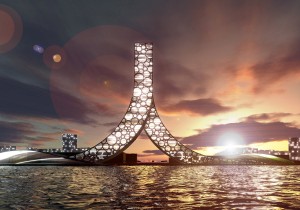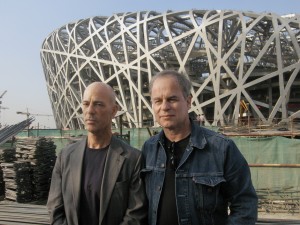Good PR need not always come from PR consultants. Like good branding, good PR is about ideas and a strategy for making these relevant… In architecture, a strong visual sensibility is essential to be a good PR advocate for a practice.
Maybe more than ever, PR is an important part in architectural practice. More and more firms engage PR consultants that help building the reputation. We talk on this topic with Laura Iloniemi, the head of Laura Iloniemi Architectural Press and PR, a media agency focused exclusively on the promotion of architecture.
Laura Iloniemi studied architectural philosophy at the University of Cambridge and arts promotion at The Ecole du Louvre in Paris. She has been working with architects, engineers and developers since 1996. Iloniemi sees the promotion of architecture as something very distinct from consumer good marketing. Much of her work has been media relations focussed. Laura Iloniemi is author of book on architectural promotion called Is It All About Image: How PR works in Architecture (published by Academy & Wiley).
 Laura Iloniemi’s book “Is It All About Image”
Laura Iloniemi’s book “Is It All About Image”
AS: Many architects believe they don’t need PR. According to you, why PR is important for architects/architectural firms?
LI: Some architects are very good at their own PR. They know how to present their work well in words and visually, and understand the needs of the media. These architects do not necessarily need external PR consultants, particularly if they are well-connected and enjoy promoting themselves. However, most architects I have met do not really like pushing their wares and have a limited understanding of what would appeal to an editor. Often they also do not have the time nor energy to pursue publications and other PR related platforms. And, of course, some architects think the work should speak for itself without any additional marketing. It’s true, good work and interesting work goes a long way.
PR is important to firms when the skills or resources are not there to do the job internally. It is important when, for whatever reason, a talented practice is not getting the recognition it deserves. It can be important in helping a firm focus on the practice it wants to be known as and even become in the future. Good PR helps differentiate practices and allows these to better communicate what they do. It is therefore important in explaining to a client or publication or institution why they should be interested in a particular practice. But, as I said, good PR need not always come from PR consultants. Like good branding, good PR is about ideas and a strategy for making these relevant; in architecture, a strong visual sensibility is, I think, essential to be a good PR advocate for a practice.
AS: How PR promotes architect and builds his reputation? Which media are the most common in use (electronic, newspapers, magazines…)?
LI: Each practice’s press target list will look different. It will vary depending on the personality of the practice and their projects. Some will focus more on design-led publications and others will find their comfort zone on the pages of the property “rags”. Some will do a bit of everything and some will shun everything but the most exclusive and erudite publications. Some will only value print and others will devour social media. I always think that you need to work with practices and their architects as individuals and marry their talents in presenting their ideas to the right media be it electronic, newspapers, magazines. No point in pushing for a comment piece from someone not keen to state an opinion in public.
 REN – People’s Building render © BIG Bjarke Ingels Group
REN – People’s Building render © BIG Bjarke Ingels Group
AS: How good architecture PR should looks like? What are good visuals and good stories?
LI: Good architecture PR should be subtle. I find it pretty cheesy when it looks corporate with PR account directors looking after clients. The writing needs to be intelligent and not fuelled by the latest jargon terms with press releases claiming everything to be “iconic”. Good visuals like good projects come in many forms, but it’s always a perk when they have a strong idea and represent something essential about the project. Good stories are often original in some way. However, visually compelling buildings tend to always make good stories because they are in and of themselves a pleasure to publish even if they are not the tallest or the most energy-efficient. And of course people like stories about buildings that are for well-known clients, or located in extraordinary locations.
AS: Is PR valuable for architecture if there are no critique and no theory?
LI: I guess PR is valuable for architecture without critique in a business sense. A lot of architectural PR is basically corporate PR with little understanding or real care for the subject. It’s about promoting practices so that they get more work. This is often done by focusing on industry events and industry publications. Looking at architecture from a more cultural perspective, this type of corporate PR could be seen as damaging because it is often thoroughly lacking any intellectual sophistication.
AS: Can you explain us how star-architects are created? Is there fashion in architecture?
LI: There are architectural fashions. Star-architecture is born from exceptional practices who are leading design thinking in some way, creating fashion. There is a misconception that these individuals are just good at PR. You may consider Norman Foster, Rem Koolhaas, Zaha Hadid, Herzog & de Meuron and perhaps David Chipperfield as star architects. The work is very varied. Some of it perhaps has star quality in a sensationalistic sense. However, what these architectural stars have in common is the ability to dedicate their lives to creating a world in and around them that supports their design ethos or concept (their ‘habitus’ even resonates this).These individuals are stars, if you like, because they have consistently adhered to their design principles and have inspired other practitioners (not least their staff) and critics, and clients of course. For them, I think, PR really is a tool. It is not at the essence of why these individuals are called star-architects.
 Herzog & de Meuron, still from “Bird’s Nest: Herzog & de Meuron in China”
Herzog & de Meuron, still from “Bird’s Nest: Herzog & de Meuron in China”